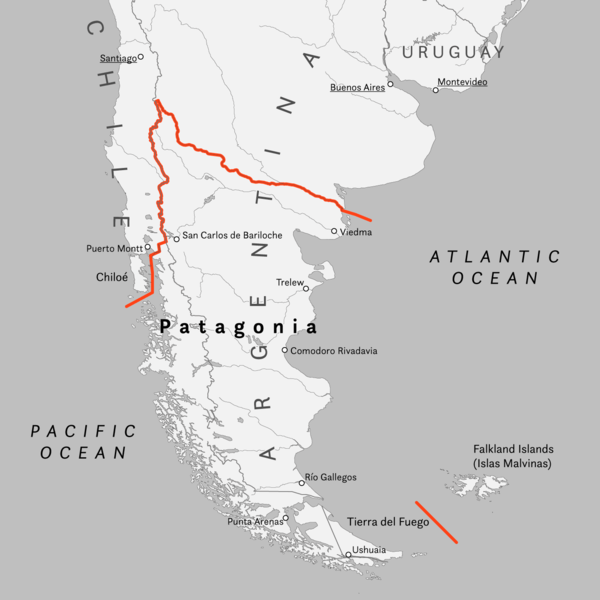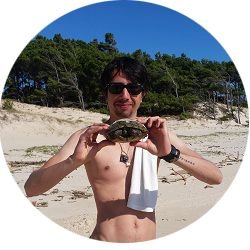Hooray you mighty readers! How are you? So much curiosity towards the Calafate tale that I'll bring two versions.
Hey guys, with the great success of last post about the Perito Moreno Glacier I'd like to first; effusively thank all those who enjoyed, commented and upvoted, you mean a lot to my motivation; second I'd like to say that'll slowly retire my photo series.
If you haven't checked that post there's still time! Travel Story: Hitchhiking to Perito Moreno Glacier & Washing Clothes on a River
I'm not a professional photographer and the photo contests seem to be getting waaaaay out of my league, plus the photo series generally doesn't bring any interaction, which makes it even worse. However, it doesn't mean I'll stop sharing my travel photos, instead, I'll post them through stories. Isn't it a lot more interesting?
Without further ado, let's talk about the Calafate tales. I know, I know... it's available on the web. But yet many people didn't know, and none of the sites will tell the way I would like to hear. That's why I'm bringing it to you.
You may have heard on my posts about the region called Patagonia. Do you know where it is?
I'd like to make this sneaky parenthesis to bring this information. I believe it makes no sense reading the patagonian tales if you don't know the region I'm talking about, right? Here enters the mighty Wikipedia - Oh boy, internet is the best source of knowledge, yet people misuse it.

Image Credits: Wikipedia Commons
Patagonia is a sparsely populated region located at the southern end of South America, shared by Argentina and Chile. The region comprises the southern section of the Andes mountains as well as the deserts, pampas and grasslands east of it. Patagonia has two coasts: western facing the Pacific Ocean and eastern facing the Atlantic Ocean. Source: Wikipedia.
Since Patagonia used to be, and still is on some parts, a vast piece of land with incredibly harsh weather during the winter, seeing native fruits is quite rare. No, you won't see coconut trees and bananas just like in the tropics. Patagonia is too windy and especially cold for that! However, there is one fruit, the Calafate. Calafate is just like a blue berry, that grows in a small tree all over Patagonia. It's not exactly a sweet fruit, nor it has the best of the flavours, but it's food, and may save you in an emergency.
All right, now that you are situated in this world of ours and know what the Calafate is, we can start the story telling. The thing is... it's widely spread by argentinians the phrase:
"Anyone who eats a Calafate berry will, one day, return to Patagonia"
This phrase has two origins, both coming from old indian tales. I'll make an adaptation of the original spanish texts, incorporating my own way of telling it. Have a seat and enjoy.
Koneex, the ancient healer
It is said that in autumn, the Ñires, Lengas and Coihues woods begin to take on a characteristic tone, announcing the season change, which produces a multicolored effect in the trees, ranging from intense red, gold and orange, transformation which has been repeating year after year for thousands of years.
In this landscape lived the Tehuelches, who are said to be the original owners of the land, whom, once the winter began, would migrate on foot towards the north looking for food and shelter, where the cold was not so intense. That year wouldn't be different.
The tribe had been observing the forest color gradually change for days, when finally they made the decision; It was time to reunite the tribe and go.
Koneex, the tribe's ancient healer, an old indian woman who could barely walk, fatigued by the years of living in harsh conditions and from presting wise services for the tribe, wasn't prepared for the journey. She seemed to feel her last drops of energy being vanished from her body. With a calm, deep and tired voice she reunited the tribe to announce her decision.
- My sons, time has come for old Koneex. I am too weak to follow you this time. I'll stay here to fulfil my destiny front the nature. All my knowledge lays in your hands and shall never be forgotten. - Koneex said.
The tribe sat there in silence, respecting the ancient woman's wishes.
- But old Koneex. You'll be alone here! We shall carry you with us. - The indian chief said.
- Old Koneex won't be alone. The birds will be here to make me company. Now go, winter is coming. - Koneex said.
Accepting her decision, the tribe started the construction of a hut using Guanaco leather, where old Koneex would spend the winter with a stash of food and an abundant pile of fire wood.
Koneex weakly watched the tribe leaving in between the trees until they disapeared in the horizon between the sky and the vast lands of the Tehuelque tribe. Inside her hut, the smoke of miraculous leaves burning filled the ambient. She's started feeling the breeze of cold winds coming from south cutting through the forest. The deadly and heavy silence echoed after every bit of living beings had migrated, leaving old Koneex to spend her last days in such loliness.
Many suns and moons had passed until winter had gone and spring slowly came back, bringing all the birds again; the Brotes, Golondrinas, Chorlos, the happy Chingolos and the Charlatanas. All the birds reunited on top of the old hut, where once Koneex had been.
That day a voice echoed from inside the hut. It was old Koneex scolding the animals for leaving her, on that harsh, dark and lone winter.
-Why have you left me when I mostly needed your companionship? - Koneex asked the birds.
- Because the autumn provides no food, and winter provides no shelter. - Answeared a wise Chingolito.
- I understand you. - Koneex said.
- From now on food and shelter shall be provided. That way I'll never be alone again. - Koneex said.
The words turned into silence and old Koneex perished. Strong wind gusts uncovered the old hut, from where the voice had echoed. From where old Koneex had spent her last days a small thorny tree with scented yellow flowers had sprouted.
The delicate yellow flowers has became a fruit, maturing during the autumn, aquired a purple color and an incredible taste of high energetic value. The birds no longer migrated and all those who had walked north returned to discover that new and delicious fruit, which they all adopted as part of their nutrition. The new tree has been named Calafate, and its seed were spreaded all over the vast lands.
That's how the tale of the Calafate has began, "Anyone who eats a Calafate berry will, one day, return".
The maiden Calafate
Calafate was a beautiful, obedient young Tehuelque woman with golden eyes. One day Calafate's tribe received a young Selknam man, to be tested among them. The young man was assigned to an initiation ritual to become a man, a ritual known as the kloketen.
It didn't take long for the two to fell in love and plan to escape together.
- You are a Selknam, my love. The chief and my dad will never agree on our union - Said Calafate to her young lover.
But the young man wasn't the type to run away. He wanted to challenge the chief, so he stupidly reunited the chief and Calafate's father to express his intentions.
- I'll become a Tehuelque, and I'll marry Calafate. You liking it or not! - He bravely said.
The men looked him in the eyes in disgust, but nothing could be done. Due to their traditions, the Tehueque could not harm the initiate during the kloketen. To prevent the relationship between his daughter and said stranger, Calafate's father had no choice but to seek the help of the tribe's shaman.
- Old shaman, I need your help. I need an enchantment to end Calafate's love. - The father said.
The old woman seemed to be one hundred years old, had dry skin and deep eyes. She ignited some leaves creating a dense smoke in the hut. She then looked at the father, without looking him in the eyes, but to nowhere.
- Old woman can't end their love. But old woman can make them separate for ever. - Said the shaman.
- I accept your enchantment, old woman. My daughter will never marry a Selknam. - Said the father.
Soon after the visit, Calafate was transformed into a never before seen small thorny tree, which had yellow flowers just like her eyes.
The young man, devastated by the broken heart, runned away from the Tehueque's lands and for months wandered through the vast dry lands, searching for his love. He wandered and cried, up until he perished in starvation. Old spirits took pity on him, seeing his miserable end. They turned him into a small and fast bird, so he could travel greater extensions of the vast patagonian lands.
That way he spent the winter and the spring, until one summer day. The young bird settled on a bush, that he had not seen before. The small tree provided small fruits that were as sweet as the heart of Calafate. The little bird would still fly over Patagonia, but he would always go back to that small tree.
It's said that everytime someone eats a Calafate fruit, the sweetness of its fruits will make the person always come back for more. That's how the tale of the Calafate has began, "Anyone who eats a Calafate berry will, one day, return for more".
Do you like these old tales? Does your place have something similar? Comment down below, I'd love to hear from you.
I hope you've enjoyed this story. If you liked it, consider giving your upvote for a hot coffee.
~Love ya all,

Disclaimer: The author of this post is a convict broken backpacker, who has travelled more than 10.000 km hitchhiking. Following him may cause severe problems of wanderlust and inquietud. You've been warned.

I'm Arthur. I blog about Adventure Stories, Brazil, Travel, Camping & Life Experiences.
Follow me to stay tuned for more craziness and tips.

5 LATEST RELATED POSTS:
Photo Series #64: Finding Balance | What is balance in life?
Travel Story: Hitchhiking to Perito Moreno Glacier & Washing Clothes on a River
[Blog #9] Cyclists Are Masochists | Training Into Headwind & A Bit About My City
Monday Morning Quote: "Difficulties are just things to overcome, after all."
Mighty Steem Explorer Game! Discover the Location & Win the SBD
A proud member of:


